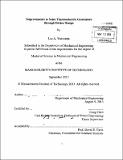| dc.contributor.advisor | Gang Chen. | en_US |
| dc.contributor.author | Weinstein, Lee A. (Lee Adragon) | en_US |
| dc.contributor.other | Massachusetts Institute of Technology. Department of Mechanical Engineering. | en_US |
| dc.date.accessioned | 2014-03-06T15:44:25Z | |
| dc.date.available | 2014-03-06T15:44:25Z | |
| dc.date.copyright | 2013 | en_US |
| dc.date.issued | 2013 | en_US |
| dc.identifier.uri | http://hdl.handle.net/1721.1/85471 | |
| dc.description | Thesis: S.M., Massachusetts Institute of Technology, Department of Mechanical Engineering, 2013. | en_US |
| dc.description | Cataloged from PDF version of thesis. | en_US |
| dc.description | Includes bibliographical references (pages 145-150). | en_US |
| dc.description.abstract | A solar thermoelectric generator (STEG) is a device which converts sunlight into electricity through the thermoelectric effect. A STEG is nominally formed when a thermoelectric generator (TEG), a type of solid state heat engine, is placed between a solar absorber and a heat sink. When the solar absorber is illuminated by sunlight, it heats up and the TEG is subjected to a temperature gradient. Heat flows through the TEG, some of which is converted to electricity. Recent advancements have improved STEG efficiency considerably, however more work is required before STEGs will be able to compete commercially with other solar to electricity conversion technologies. This thesis explores two device level improvements to STEG systems. First, thin-film STEGs are explored as a method to potentially reduce the manufacturing costs of STEG systems. It is shown through modeling that thin-film STEGs have only a slight degradation in performance compared to bulk STEGs when identical materials properties are used. Two parameters are found which can guide device design for thin-film STEGs regardless of system size. Second, an optical cavity is investigated which can improve opto-thermal efficiency for STEGs or any other solar-thermal system. The cavity improves performance by specularly reflecting radiation from the absorber back to itself, reducing radiative losses. It is shown through modeling and with some preliminary experimental results that such a cavity has the potential to significantly improve the opto-thermal efficiency of solar-thermal systems and operate efficiently at high absorber temperatures without the use of extremely high optical concentration ratios. | en_US |
| dc.description.statementofresponsibility | by Lee A. Weinstein. | en_US |
| dc.format.extent | 150 pages | en_US |
| dc.language.iso | eng | en_US |
| dc.publisher | Massachusetts Institute of Technology | en_US |
| dc.rights | M.I.T. theses are protected by copyright. They may be viewed from this source for any purpose, but reproduction or distribution in any format is prohibited without written permission. See provided URL for inquiries about permission. | en_US |
| dc.rights.uri | http://dspace.mit.edu/handle/1721.1/7582 | en_US |
| dc.subject | Mechanical Engineering. | en_US |
| dc.title | Improvements to solar thermoelectric generators through device design | en_US |
| dc.title.alternative | Improvements to STEGs through device design | en_US |
| dc.title.alternative | Improvements to solar TEGs through device design | en_US |
| dc.type | Thesis | en_US |
| dc.description.degree | S.M. | en_US |
| dc.contributor.department | Massachusetts Institute of Technology. Department of Mechanical Engineering | |
| dc.identifier.oclc | 870970086 | en_US |
